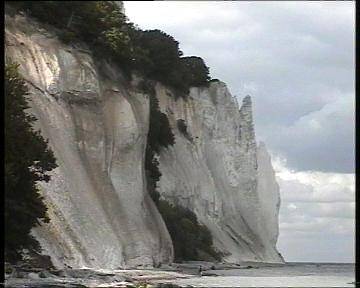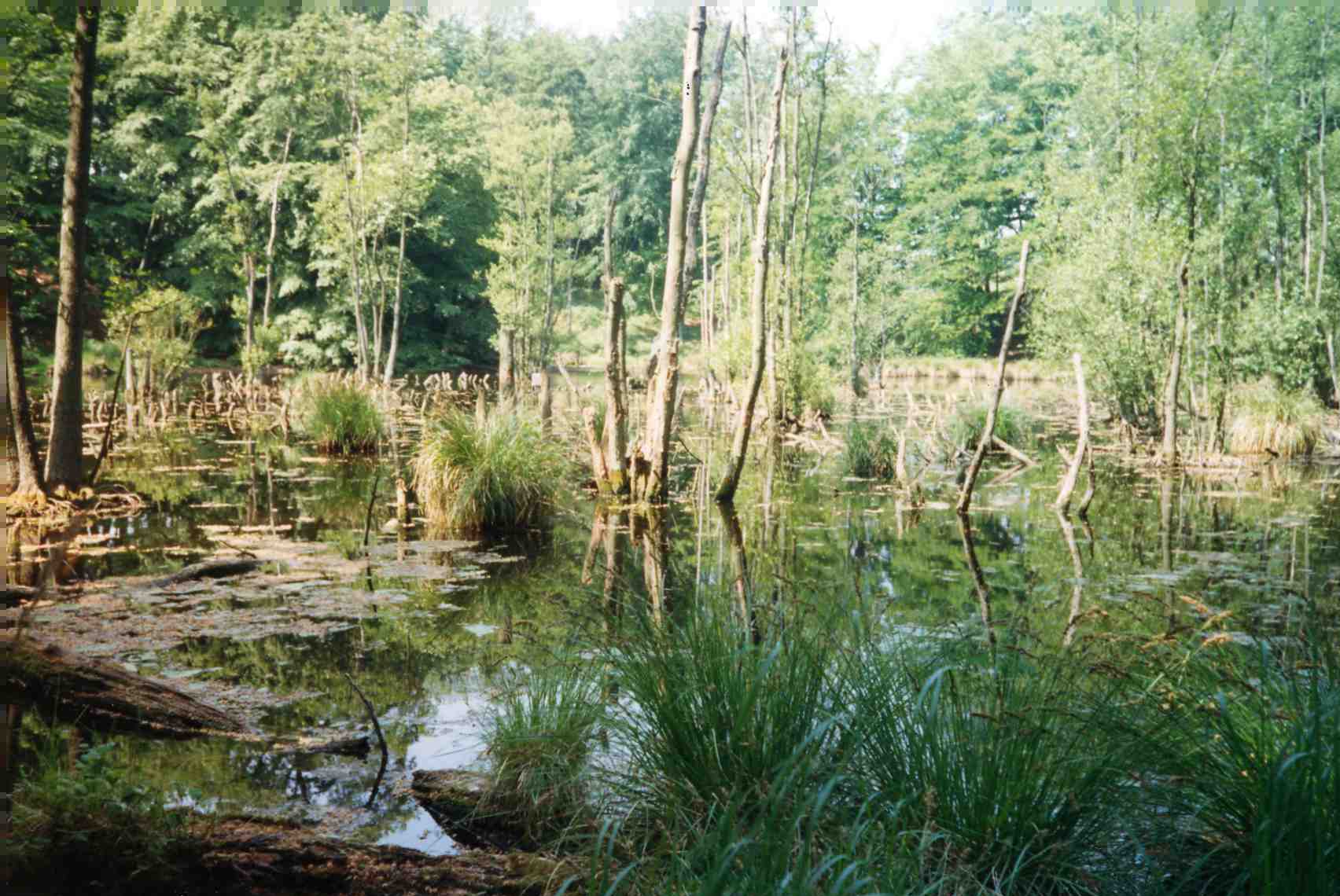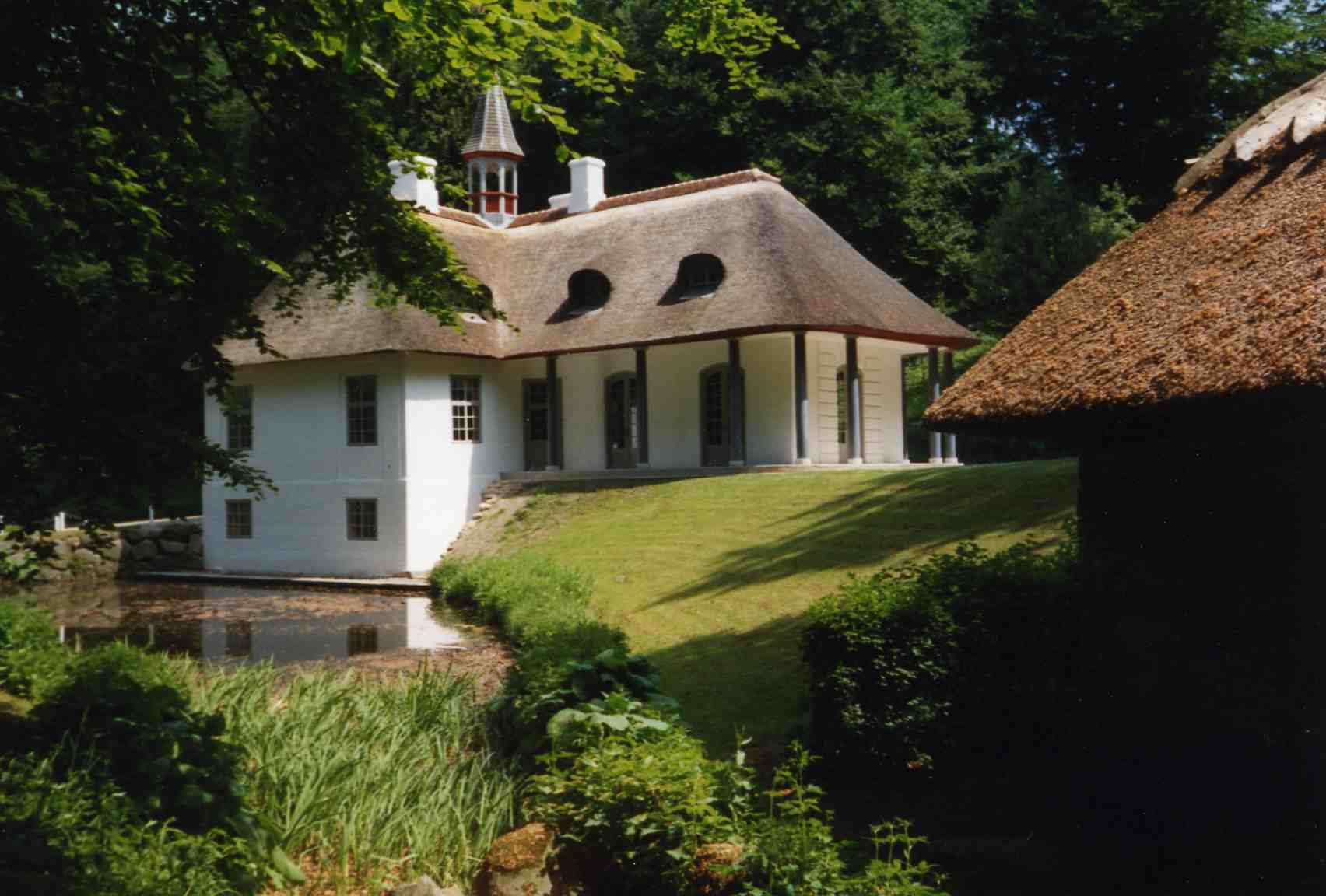Møns Klint on:
[Wikipedia]
[Google]
[Amazon]

 Møns Klint is a 6 km stretch of
Møns Klint is a 6 km stretch of
 The chalk forming the cliffs consists of the remains of shells from millions of microscopic creatures ( coccolithophores) which lived on the seabed over 70 million years ago. As a result of huge pressure from glaciers moving west, the terrain was compacted and pushed upwards, forming a number of hills and folds. When the ice melted at the end of the last
The chalk forming the cliffs consists of the remains of shells from millions of microscopic creatures ( coccolithophores) which lived on the seabed over 70 million years ago. As a result of huge pressure from glaciers moving west, the terrain was compacted and pushed upwards, forming a number of hills and folds. When the ice melted at the end of the last
 Because of the special nature of the chalky soil, there are many rare plants in the area, particularly several varieties of
Because of the special nature of the chalky soil, there are many rare plants in the area, particularly several varieties of  In recent years, the
In recent years, the
 Klintholm Estate, da, Klintholm Gods, to the west of the wooded area along the cliffs, is a collection of old farm buildings dating back to 1780 and a large park. The manor house which used to form part of the estate was demolished in 2000 as a result of dry rot.
The GeoCenter Møns Klint is a geological museum close to the top of the chalk cliffs. The museum explains the geology of the chalk cliffs and has exhibitions on the fossils found in the chalk. Near the museum start several walks to the cliffs, including two spectacular stairways from the top of the cliff to the beach.
Klintholm Estate, da, Klintholm Gods, to the west of the wooded area along the cliffs, is a collection of old farm buildings dating back to 1780 and a large park. The manor house which used to form part of the estate was demolished in 2000 as a result of dry rot.
The GeoCenter Møns Klint is a geological museum close to the top of the chalk cliffs. The museum explains the geology of the chalk cliffs and has exhibitions on the fossils found in the chalk. Near the museum start several walks to the cliffs, including two spectacular stairways from the top of the cliff to the beach.
File:Eckersberg møns klint.jpg, View of Møns Klint and Sommerspiret by
File:Klintekorset ved Møens klint.jpg, Cliff cross at Møns Klint by
Hybrid map from Google maps showing the cliffs along the eastern coast of Møn
The large landslide of Store Taler (now Store Taler Fald) in 2007
{{DEFAULTSORT:Mons Klint Cliffs of Denmark Møn Tourist attractions in Region Zealand Geology of Denmark

 Møns Klint is a 6 km stretch of
Møns Klint is a 6 km stretch of limestone
Limestone ( calcium carbonate ) is a type of carbonate sedimentary rock which is the main source of the material lime. It is composed mostly of the minerals calcite and aragonite, which are different crystal forms of . Limestone forms wh ...
and chalk
Chalk is a soft, white, porous, sedimentary carbonate rock. It is a form of limestone composed of the mineral calcite and originally formed deep under the sea by the compression of microscopic plankton that had settled to the sea floor. Cha ...
cliff
In geography and geology, a cliff is an area of rock which has a general angle defined by the vertical, or nearly vertical. Cliffs are formed by the processes of weathering and erosion, with the effect of gravity. Cliffs are common on ...
s along the eastern coast of the Danish island of Møn
Møn () is an island in south-eastern Denmark. Until 1 January 2007, it was a municipality in its own right but it is now part of the municipality of Vordingborg, after merging with the former municipalities of Langebæk, Præstø, and Vordin ...
in the Baltic Sea
The Baltic Sea is an arm of the Atlantic Ocean that is enclosed by Denmark, Estonia, Finland, Germany, Latvia, Lithuania, Poland, Russia, Sweden and the North and Central European Plain.
The sea stretches from 53°N to 66°N latitude and fr ...
. Some of the cliffs fall a sheer 120 m to the sea below. The highest cliff is , which is 128 m above sea level. The area around Møns Klint consists of woodlands, pastures, ponds and steep hills, including '' Aborrebjerg'' which, with a height of 143 m, is one of the highest points in Denmark. The cliffs and adjacent park are now protected as a nature reserve. Møns Klint receives around 250,000 visitors a year. There are clearly marked paths for walkers, riders and cyclists. The path along the cliff tops leads to steps down to the shore in several locations.
On 29 May 2007, close to the cliff tops, the GeoCenter Møns Klint was opened by Queen Margrethe
Margrethe II (; Margrethe Alexandrine Þórhildur Ingrid, born 16 April 1940) is Queen of Denmark. Having reigned as Denmark's monarch for over 50 years, she is Europe's longest-serving current head of state and the world's only incumbent femal ...
. The geological museum with interactive computer displays and a variety of attractions for children traces the geological prehistory of Denmark and the formation of the chalk cliffs. The museum was designed by PLH Architects PLH Architects is an architectural firm based in Copenhagen, Denmark. It was founded in 1977 by Palle Leif Hansen.
Location
PLH Arkitekter is based in a former industrial complex situated in the Haraldsgade neighbourhood on the border between out ...
, the winners of an international design competition
A design competition or design contest is a competition in which an entity solicits design proposals from the public for a specified purpose.
Architecture
An architectural design competition solicits architects to submit design proposals for a b ...
.
Geology
ice age
An ice age is a long period of reduction in the temperature of Earth's surface and atmosphere, resulting in the presence or expansion of continental and polar ice sheets and alpine glaciers. Earth's climate alternates between ice ages and gre ...
about 11,000 years ago, the cliffs emerged. They form part of the same deposits as the cliffs of Rügen
Rügen (; la, Rugia, ) is Germany's largest island. It is located off the Pomeranian coast in the Baltic Sea and belongs to the state of Mecklenburg-Western Pomerania.
The "gateway" to Rügen island is the Hanseatic city of Stralsund, w ...
, Germany, on the other side of the Baltic. Today, it is possible to find fossils of various types of shellfish as the sea continues to erode the chalk.
Erosion also caused one of the highest points on the cliffs, the ''"Sommerspiret"'', to fall into the sea in 1998, and in January 2007, there was an even larger landslide around the ''Store Taler'', in the northern part of the cliffs, creating a 300-m long peninsula of chalk and fallen trees stretching out into the sea below.
Nature
 Because of the special nature of the chalky soil, there are many rare plants in the area, particularly several varieties of
Because of the special nature of the chalky soil, there are many rare plants in the area, particularly several varieties of orchid
Orchids are plants that belong to the family Orchidaceae (), a diverse and widespread group of flowering plants with blooms that are often colourful and fragrant.
Along with the Asteraceae, they are one of the two largest families of flowering ...
which are at their best in early summer. In particular, the tall lady orchid (Orchis purpurea) grows under the staircases leading down to the beach. The chalk also provides a distinctive light green tint to the beech trees along the top of the cliffs, maintaining their spring hues throughout the summer season. In the hilly park which stretches a couple of kilometers inland, there are a number of ponds and marshes, many populated by trees. Several signposted circuits provide opportunities for walkers, riders and cyclists to discover the surroundings.
 In recent years, the
In recent years, the peregrine falcon
The peregrine falcon (''Falco peregrinus''), also known as the peregrine, and historically as the duck hawk in North America, is a cosmopolitan bird of prey ( raptor) in the family Falconidae. A large, crow-sized falcon, it has a blue-grey ...
, the fastest of all birds as it swoops down to its prey at 350 km/h, has been observed breeding on Møns Klint. And the extremely rare large blue butterfly (Maculinea arion) can also be found in the area.
Points of interest
Liselund Park, at the northern end of the cliffs, is an attractive combination of small houses, ponds and rolling lawns built by Antoine de la Calmette for his wife Elisabeth or ''Lise'' at the end of the 18th century. Klintholm Estate, da, Klintholm Gods, to the west of the wooded area along the cliffs, is a collection of old farm buildings dating back to 1780 and a large park. The manor house which used to form part of the estate was demolished in 2000 as a result of dry rot.
The GeoCenter Møns Klint is a geological museum close to the top of the chalk cliffs. The museum explains the geology of the chalk cliffs and has exhibitions on the fossils found in the chalk. Near the museum start several walks to the cliffs, including two spectacular stairways from the top of the cliff to the beach.
Klintholm Estate, da, Klintholm Gods, to the west of the wooded area along the cliffs, is a collection of old farm buildings dating back to 1780 and a large park. The manor house which used to form part of the estate was demolished in 2000 as a result of dry rot.
The GeoCenter Møns Klint is a geological museum close to the top of the chalk cliffs. The museum explains the geology of the chalk cliffs and has exhibitions on the fossils found in the chalk. Near the museum start several walks to the cliffs, including two spectacular stairways from the top of the cliff to the beach.
Access
Møns Klint can be reached by road either directly from Stege or from Klintholm Havn. In the summer, there is a regular bus service. Accommodation is available within the cliff area itself or in hotels and pensions in the vicinity. There is a camping site close to the main entrance to the park and a youth hostel nearby.Møns Klint in art
Møns Klint has been a popular subject for landscape painters, especially during theDanish Golden Age
The Danish Golden Age ( da, Den danske guldalder) covers a period of exceptional creative production in Denmark, especially during the first half of the 19th century.Kulturnet DanmarkGuide to the Danish Golden Age Although Copenhagen had suffered ...
when the national romanticism movement encouraged artists to take renewed interest in the Danish countryside. A few examples are shown below.
Christoffer Wilhelm Eckersberg
Christoffer Wilhelm Eckersberg (2 January 1783 – 22 July 1853) was a Danish painter. He was born in Blåkrog in the Southern Jutland region of Denmark. He went on to lay the foundation for the period of art known as the Golden Age of Dan ...
(1809)
File:Skovgaard Parti fra Møns Klint.jpg, Part of Møns Klint by Peter Christian Skovgaard (1852)
File:Sødring Møns Klint Sommerspiret.jpg, Part of Møns Klint with the Sommerspiret by Frederik Hansen Sødring (1830)
File:Louis gurlitt møns klint.jpg, Møns Klint by Louis Gurlitt
Heinrich Louis Theodor Gurlitt (8 March 1812 – 19 November 1897), also called Louis Gurlitt, was a Danish-German painter of landscapes. His brother was the composer Cornelius Gurlitt, and his son was the architect and art historian also cal ...
(1842)
Christian Dahl
Christian M. Dahl (August 21, 1856 – August 4, 1923) was a North Dakota Republican Party politician who served as the 2nd Secretary of State of North Dakota from 1893 to 1896.
Christian M. Dahl was an immigrant from Norway. He first won electi ...
(1815)
File:Udsigt over havet fra Taleren på Møns Klint, 1851.jpg, View of the sea from Taleren on Møns Klint by Peter Christian Skovgaard (1851)
File:Sødring Kreidefelsen Møn.jpg, Chalk cliff on Møn by Frederik Hansen Sødring (1831)
File:Djævlekløften i Liselunds have på Møn (Eckersberg).jpg, Devil's cleft at Liselund by Christoffer Wilhelm Eckersberg
Christoffer Wilhelm Eckersberg (2 January 1783 – 22 July 1853) was a Danish painter. He was born in Blåkrog in the Southern Jutland region of Denmark. He went on to lay the foundation for the period of art known as the Golden Age of Dan ...
(1809)
File:Skovgaard Udsigt over havet fra Møens Klint 1850.JPG, View over the sea from Møns Klint by Peter Christian Skovgaard (1850)
References
External links
Hybrid map from Google maps showing the cliffs along the eastern coast of Møn
The large landslide of Store Taler (now Store Taler Fald) in 2007
{{DEFAULTSORT:Mons Klint Cliffs of Denmark Møn Tourist attractions in Region Zealand Geology of Denmark